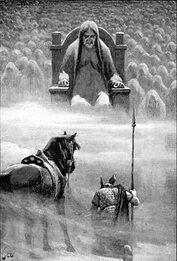From what is known as her 'sick bed' she rules her kingdom, the destination of those who have not lived a good life, a place of disease, a place of the old and a place of those who did not die a brave death on the battlefield.
Helhiem is described thus:
Iron-barred, with massive wall;
Horrible that palace tall!
Hunger was her table bare;
Waste, her knife; her bed, sharp Care;
Burning Anguish spread her feast;
Bleached bones arrayed each guest;
Plague and Famine sang their runes,
Mingled with Despair’s harsh tunes.
Misery and Agony
E’er in Hel’s abode shall be!”
In fact, it is exactly where Hel is sitting rather ominously in the image above, welcoming a dead warrior.
The inscription "Abandon all hope, ye who enter here" should be prominently displayed somewhere don't you think?


 RSS Feed
RSS Feed
